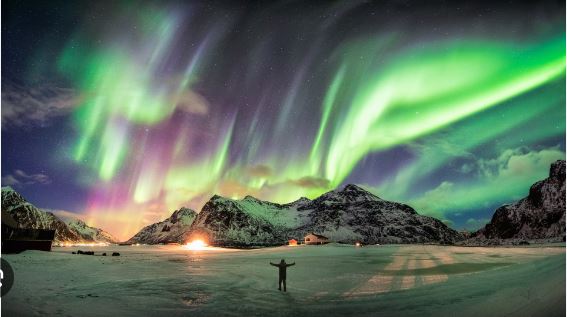
GOOD NEWS: Top Strategies and Places to See the Beauty of the Aurora Borealis This Winter.
The Aurora Borealis, or Northern Lights, is one of nature’s most mesmerizing phenomena, enchanting those lucky enough to witness it. Every winter, the skies over northern regions come alive with brilliant displays of light, as solar particles interact with Earth’s atmosphere, producing dancing waves of green, pink, purple, and sometimes red.
If you’ve ever dreamed of experiencing the Aurora Borealis, there’s no better time than this winter. However, seeing the Northern Lights requires some planning and luck, as the phenomenon is subject to weather conditions and solar activity. Below are some of the best strategies and places to witness this awe-inspiring spectacle.
1. Pick the Right Location
Certain regions in the northern hemisphere are renowned for offering the best views of the Northern Lights. For the clearest skies and most frequent aurora activity, aim for locations near the Arctic Circle. Here are some of the top destinations:
- Tromsø, Norway: Often referred to as the “Gateway to the Arctic,” Tromsø is one of the best spots in the world for viewing the Northern Lights. Situated in northern Norway, it offers an excellent vantage point for seeing the aurora during the winter months. Additionally, the city offers various Northern Lights tours, including reindeer sledding and boat trips, allowing you to enjoy the beauty of the lights in different settings.
- Abisko, Sweden: Located in Swedish Lapland, Abisko is renowned for its “blue hole” effect—a patch of sky over Lake Torneträsk that remains clear even when surrounding areas are cloudy. The Abisko National Park is a prime destination for travelers looking for a reliable spot to witness the lights. The nearby Aurora Sky Station offers an elevated viewing experience.
- Reykjavik, Iceland: Iceland’s capital is a popular stop for Northern Lights seekers. While you can see the aurora from the city itself, venturing out to more rural areas, such as Thingvellir National Park or the black sand beaches of Vik, enhances your chances of seeing the lights without light pollution. Iceland’s geothermal hot springs also provide a unique way to enjoy the spectacle from the warmth of a natural spa.
- Fairbanks, Alaska: This city lies directly under the aurora oval, a circular zone where auroral activity is concentrated. Fairbanks offers a good balance between accessibility and prime viewing opportunities. Nearby areas like Chena Hot Springs also provide spectacular views, with the added bonus of relaxing in hot springs under the Northern Lights.
- Yellowknife, Canada: Located in the Northwest Territories, Yellowknife is another excellent destination for aurora hunters. The long, dark winter nights and relatively clear skies make it one of the best places in Canada to see the lights. Aurora Village, a dedicated Northern Lights viewing spot, offers cozy teepees and heated viewing chairs to enhance your experience.
2. Time Your Trip Right
Winter is the best season for viewing the Northern Lights, as the long, dark nights offer optimal conditions. While the aurora is visible from late September to early April, the peak viewing months are typically December through March. During this time, solar activity tends to be high, and the longer nights mean more time to catch a glimpse of the lights.
For the best chances of seeing the Aurora Borealis, plan your trip around the new moon phase, as a dark sky will provide better visibility. Checking aurora forecasts before your trip can also help you determine when solar activity will be strongest.
3. Avoid Light Pollution
To fully appreciate the Aurora Borealis, you need to be far from city lights. Rural areas and national parks offer the clearest skies, free from light pollution. Most Northern Lights tours take place in remote regions specifically chosen for their dark skies, allowing the natural beauty of the aurora to shine through.
Even if you’re staying in a city like Reykjavik or Tromsø, consider taking a short drive or tour to nearby dark-sky locations. Some hotels in these regions are designed with aurora-viewing in mind, with large windows or outdoor hot tubs so you can enjoy the lights without having to venture far.
4. Be Patient and Stay Flexible
The Northern Lights are unpredictable and depend on both solar activity and weather conditions. Cloud cover can block your view, and on some nights, the aurora may not appear at all. It’s essential to stay flexible during your trip, allowing extra days to increase your chances of seeing the lights.
Most destinations offer a variety of winter activities that can keep you entertained while you wait for the right conditions. Whether it’s dog sledding, snowshoeing, or exploring ice caves, there’s plenty to do in aurora-viewing regions, so even if the lights don’t appear one night, you’ll have an unforgettable experience.
5. Check Aurora Forecasts
Before heading out, it’s important to check real-time aurora forecasts. Websites and apps like the Aurora Forecast and the Space Weather Prediction Center offer updates on solar activity and the likelihood of auroral displays. Some apps even provide alerts when activity is high, giving you a better chance of catching the lights.
Monitoring the KP index (a scale that measures geomagnetic activity) is another useful tool. A KP index of 3 or higher indicates stronger solar activity and better aurora visibility.
6. Dress Warmly
Northern Lights destinations in the Arctic are known for their frigid winter temperatures. Dressing warmly is essential, as you may spend long hours outside waiting for the aurora to appear. Layers are key—opt for thermal underwear, insulated jackets, wool socks, and waterproof boots. Don’t forget accessories like gloves, scarves, and hats to stay comfortable during your aurora hunt.

Leave a Reply